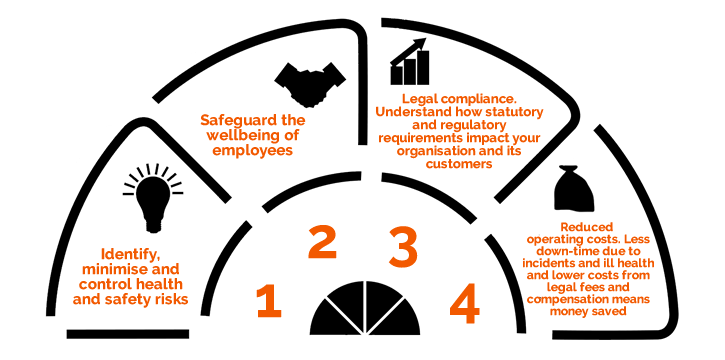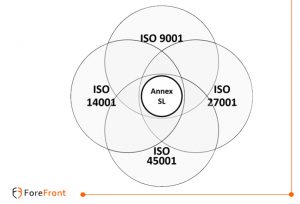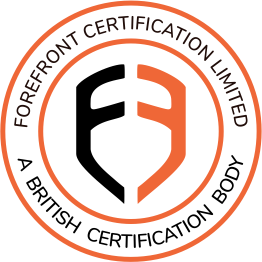ISO 45001 Certification (OHSMS)
ISO 45001 provides increase safety, reduce workplace risks and enhance health and well-being at work, empowering an organisation to improve its OH&S performance proactively.
Benefits of ISO 45001 (OHSMS) Certification
- Create an environment of health and safety; therefore workforce’s morale is high and participates actively in their health and safety.
- A decrease in workplace accidents.
- Reduce absenteeism and staff turnover, leading to improved efficiency.
- Cost of insurance premiums may reduce.
- Able to meet legal and regulatory requirements.
- Enhance your organisations’ reputation by demonstrating your commitment to Health and Safety.
What is ISO 45001 Certification Process?

Integrated Management Systems
There are various mutual fundamentals between ISO 9001, ISO 14001, ISO 45001 and ISO 27001. E.g. Document control, management review, document control, corrective action and the requirement for competent personnel. According to Annex SL, a new high-level structure, you can combine these standards into a single joint system.
Get a free quoteReference ISO.org
ISO 45001 applies to all organisations, irrespective of size, nature of business or sector. The framework for ISO 45001 provides increase safety, reduce workplace risks and enhance health and well-being at work, empowering an organisation to improve its OH&S performance proactively. The implementation of an ISO 45001 (OHSMS) management system is a strategic and operational decision for an organisation. The success of the OHSMSmanagement system rest on leadership, commitment and participation from all levels and functions of the organisation.
Benefits ISO 45001 certification
- Create an environment of health and safety; therefore workforce’s morale is high and participates actively in their health and safety.
- A decrease in workplace accidents.
- Reduce absenteeism and staff turnover, leading to improved efficiency.
- Cost of insurance premiums may reduce.
- Able to meet legal and regulatory requirements.
- Enhance your organisations’ reputation by demonstrating your commitment to Health and Safety.

Injury can occur to staff working at a desk (e.g. back and neck problems), using stairs (e.g. slips and trips), working at heights, drivers who are on the road majority of the times or handling hazardous material.
The organisations are accountable for the health and safety of the workers and others who can affect because of organisations’ activities. Therefore, the company must provide a safe and healthy workplace, preventing work-related injuries and accidents. This responsibility embraces promoting and protecting their physical and mental health. Therefore, it is critically vital for the organisation to eradicate hazards and minimise health and safety risks by taking effective preventive and protective procedures.
There are various common fundamentals between ISO 9001, ISO 14001, ISO 45001 and ISO 27001. E.g. Document control, management review, , corrective action and the requirement for competent personnel. According to Annex SL, a new high-level structure, you can combine these standards into a single joint system.
Benefits of Integrated Management Systems
- Integrated Management Systems will have a constructive impact on the outcomes of the ISO Management Systems.
- will be able to align common components of management system standards. E.g. policies, objectives, processes and resources. Also, you may be able to have a single procedure for, document control, management reviews, training, internal audits or improvements.
- Maintaining the system will become easy to understand. Therefore, there will be more focus on achieving objectives that are central to the organisation.
- Organisations will be able to have a systematic approach to changes. Therefore, decision making will be more comfortable.
- Organisations will be able to conduct integrated audits and assessments. Therefore, optimise processes and resources. And will result in less interruption and thus decrease costs.
- Resources will focus on process implementation and add value rather than additional system maintenance.
- Will require less maintenance for continuing compliance checks to ensure that you are maintaining the management system standards requirements. Therefore, there will be more focus on improvements rather than maintaining multiple systems.
What is Annex SL?

Annex SL a new high-level structure for all ISO Management System Standards in future.
Annex SL is not an ISO standard. However, it is a guide to help ISO consultants and organisations to implement multiple/integrated (MMS/IMS) Management Systems Standards. Over the years, ISO has published several management system standards for areas of quality, environment, information security, health and safety and many more. ISO management system standards share common fundamentals. However, they are not sufficiently aligned, so they were difficult to integrate at the implementation phase. The most significant disadvantage was the duplication of work. The guideline of Annex SL will help you to create a system that entails less maintenance and resources, e.g. producing one document or process instead of many.
“It is the publication of Annex SL (formerly ISO Guide 83) which outlines the framework for a generic management system. All new ISO Management System Standards (MSS) will follow to this framework, and all current MSS will migrate to the structure at their succeeding revision.
In future, all ISO Management System Standards (MSS) should be consistent and compatible - they will all have the same look and feel. Annex SL guidelines could be the commencement of the end of the conflicts, duplication, confusion and misunderstanding arising from slightly different requirements across the various ISO Management System Standards.”
Reference IRCA briefing note Annex SL
Annex SL (a high-level structure ) is created to incorporate more than one ISO standard. Several organisations seek to implement and certify multiple management system standards such as ISO 9001, ISO 14001, ISO 27001 and ISO 45001. Implementation of more than one standard has led to the necessity to combine or integrate them effectively and efficiently. Annex SL (a high-level structure ) helps the organisations to incorporate these standards. Annex SL defines the outline for a conventional ISO Management System.
The Annex SL structure and commonly used terms and definitions will make it easier to comply with and maintain the ISO standards requirements with less time and at a lower cost.
The most popular standards using Annex SL are:
- ISO 9001:2015 Quality Management System (QMS)
- ISO 14001:2015 Environmental Management System (EMS)
- ISO 27001 Information technology Management System (ISMS)
- ISO 45001:2018 Occupational Health & Safety Management System Standard (OHSMS)
At Forefront, we believe that certification should add value to your organisation. We are not merely offering a compliance audit, however, by also maintaining a commitment to impartiality, we will dedicate our expertise towards your business, so you feel your accomplishment of achieving certification means something and not just a badge on the wall.
At Forefront, we commit to fixed daily rates with no hidden fees. However, the number of days which depends on the scope (What exactly you do) and the size of the organisation (e.g. the number of employees and number of shifts and sites) are calculated according to the UKAS specified guidelines.

